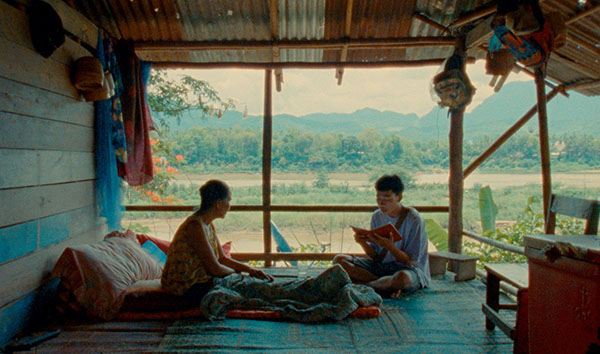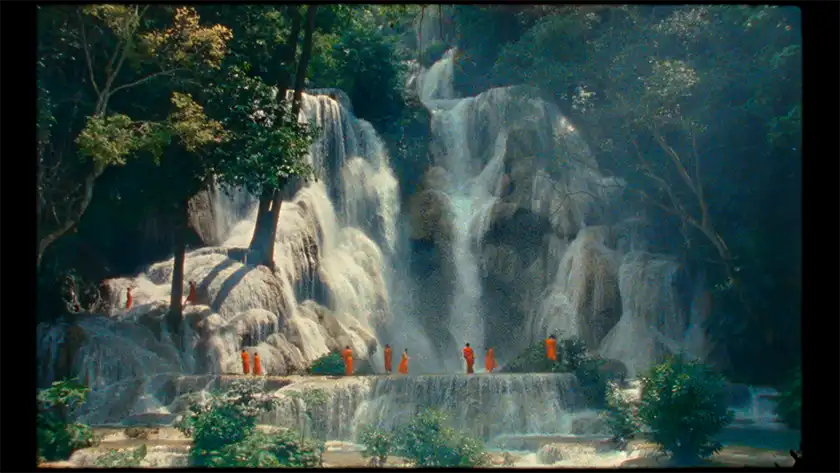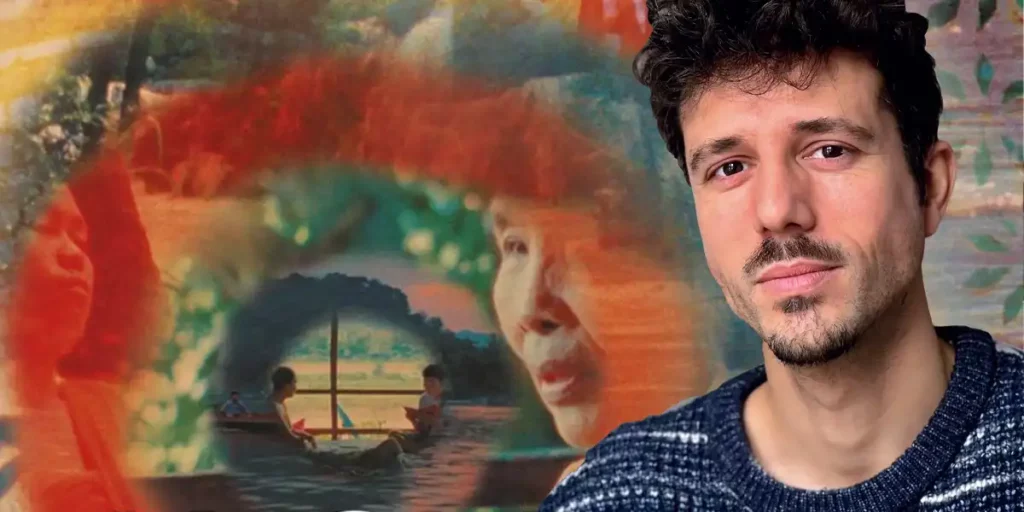We sat down for an interview with director Lois Patiño to discuss his latest film, Samsara, which is a groundbreaking cinematic experience like no other.
Lois Patiño’s second feature film, Samsara, is split into three thematically connected parts. The first focuses on young Buddhist monks in Laos whilst the third switches to Zanzibar and follows a young Muslim girl; the less said about the second part the better, as this middle section is so utterly captivating and spellbinding, it deserves to be experienced with as clear a mind as possible.
Throughout Samsara, Patiño guides us elegantly through spiritualism and religion, inviting us to look at the world anew, to reflect on concepts such as reincarnation and death. It plays out similarly to an Apichatpong Weerasethakul (Memoria) film, with long takes and slow camera pans. Samsara looks at two of the world’s biggest religions—focussing more on Buddhism than Islam—in the most painterly and evocative way possible. The visual style and sound design is striking; superimposed images and heightened colours enhance our viewing experience.
The end result is something that is difficult to put into words. After Samsara was screened at the London Film Festival in October 2023, we were lucky enough to sit down for an interview with director Lois Patiño to talk about his latest film, discussing its religious and spiritual aspects, his inspirations, and how he ensures the audience member is more than just a simple viewer.
THE WORLD AROUND US: LOIS PATIÑO ON THE INSPIRATIONS BEHIND SAMSARA
Thank you for talking to me today! I saw Samsara at the Berlin Film Festival for its world premiere in February 2023 and adored the film so much. It has been about eight months since I saw it, but I can still vividly remember it. What were your inspirations behind Samsara?
Lois Patiño: I really like trying to open the cinema language to new expressions. Every form of art is infinite; we can boost the boundaries of what they are and take cinema to new directions just like the masters such as Béla Tarr or Pedro Costa have done. Thanks to them, we understand cinema in a wider way. I try to approach it with humility, attempting to bring something new.
I am also very interested in reflecting on an anthropological way of life, in the ways different cultures live, different from the Western way. How do different groups reflect about life and death, and how do they think about the afterlife? I am interested in how people think about the afterlife.
In Red Moon Tide [Patiño’s second feature film], I was exploring the concept of death from my culture, which is Galicia, and the ideas of phantoms, spectral and limbo. It is the idea of the invisible. I started to think about this invisibility and asked how we can work with this idea in cinema? And suddenly, this very little idea of making a film that you watch with your eyes closed came to me.
Around a year after this, I found a book called ‘Bardo Thodol’, which is the ‘Tibetan Book of the Dead’. It is the description from the Buddhist perspective of what we will find in the afterlife. I thought it would be very interesting to do a trip through the afterlife from the Buddhist concept with our eyes closed.

That leads perfectly to my next question about the middle part of Samsara. I’ve never experienced anything like that in the cinema. Could you talk about that section and what the design process behind it was like?
LP: I had the idea that the audience would close their eyes, but I also wanted them to have an experience of light on screen. In ‘Bardo Thodol’, they explain that you follow different colours through this trip. I thought about doing that, but depending on the screen you are watching Samsara on, as well the size and distance, you might experience the lights more than the colours, so I decided to focus on the light/dark experience. It was also not possible to follow the colours that ‘Bardo Thodol’ says, so I worked quite freely on this aspect.
I was also very inspired by an artist called James Turrell, who is a light artist from California. He turns galleries into spaces of infinite light. You cannot understand the space and there is nothing in view to reach. He works with fading colours, so you really feel like you are breathing the light. That experience touched me a lot and I wanted to recreate this experience. The lighting at the end of the middle section flashes a lot, but there are also moments where they are slower, fading in and out.
Could you talk more about the three-part structure of Samsara?
LP: The first idea was the middle part of Samsara. When I eventually matched it to the ‘Bardo Thodol’ book and decided it would be with closed eyes experiencing the journey to the afterlife, I already had the structure. We have Laos and Zanzibar, and I used two different DOPs [Mauro Herce and Jessica Sarah Rinland], one in each place. I wanted that relationship with reality to change and feel differently before and after reincarnation. The sound designer [Xabier Erkizia] was the same for both locations. The sound is the soul, and the soul remains, whereas the image is the body.
The narrative and its three parts were made for that: a comparative, open exploration of how we conceive life and death. By choosing to reincarnate the character as an animal, it allowed me to show this understanding of life and the world from a different perspective, not only culturally, but from the perspective of an animal too.
I was very aware of my position as a white European guy travelling to these places, but we did our best to reflect their reality in the more documentary-based elements without contaminating it with our own views. We listened a lot and tried to understand these ways of living.
PORTRAYING DIFFERENT CULTURES: LOIS PATIÑO ON THE PROCESS BEHIND SAMSARA
Where did you find the locations and the actors?
Lois Patiño: There is just one professional actress in Samsara: the older woman in Laos. It was very difficult to find someone there who wanted to play an ill character who is dying, because most of them are animistic believers who think doing that could bring bad luck. So for that character, we found a professional actor as opposed to an amateur actor. At the end of the shooting, we had to do a ritual with her family and neighbours to purify the experience.

It is obviously a sensitive subject, in terms of handling and portraying these religions with care and respect. What was your research process like and how did that inform the film?
LP: From the beginning, the idea of Samsara was to celebrate cultural diversity and compare different approaches and perspectives to ideas relating to life and death. In each country [Laos and Zanzibar], we got involved with the communities that we were portraying. We wanted to speak to them and understand their fears and desires. We also tried to explore the different branches of Buddhism too.
For example, some branches believe that reincarnation is immediate. The official religion in Laos thinks that. This obviously contradicts the middle part of Samsara. But other people in Laos believe it takes a while. I was also interested in the old lady wanting to reincarnate into an animal, because officially in Buddhism, reincarnating as an animal is seen as ‘lower level’ almost. I was always trying to think spiritually without being fixed in religion.
We all have a spiritual, transcendental layer on us. You can feel it in our religions, but it is something that goes beyond the rules of religion. This freedom of choice was something I really wanted to show, to understand your spirituality liberally. You need to know and understand this through other cultures, which I tried to show in Samsara. The way we are living is one, but there are many other cultural frames.
INVITING THE VIEWER: HOW THE AUDIENCE BECOMES A PARTICIPANT IN SAMSARA
At times in Samsara, the viewer is more like a participant. There is a moment where two of the young monks look at a tree. They think about what it’s doing lying on its side and you leave the camera stationary from their point-of-view for quite a few minutes. What was your thinking behind these sorts of moments, where you elevate the audience member into something more than just a viewer?
Lois Patiño: A film for me is an experience. One of the big differences between traditional documentaries and more creative ones is about dealing with this concept of the ‘experience’. It isn’t just sending information but bringing the viewer to the experience in its own time and space, staying there with the subject.
In the specific scene you mention, the monk is trying to give a lesson to his brother. I wanted the spectator to receive this too, to have the experience along with the monk. It is a very important dialogue, as it deals with an essential idea of spirituality, which is of course part of many parts of the religion and of the ‘Bardo Thodol’ book. The teenager says: “Recognise every light as your own light, recognise every sound as your own sound”.
In all of my films, I work around this idea: that we are all connected. The teenager also invites the other monk to put himself in the position of that branch in the river, to experience its problems and concerns.
In a wider sense, what did you want audiences to get from this film? It will obviously differ from person to person, but for myself, it invited me to think about spiritualism and reincarnation. It made me look at the world differently.
LP: I’ve been working with these themes in my previous work. On one level, I’d like people to see the spiritual part of their mind, which we all have. Sometimes it is more hidden, or we want to hear it more. I’m not religious; I feel more in these animistic and spiritual ways. Samsara was perhaps a reminder of these spiritual aspects of ourselves.
It is also very important to me that we try to open our perspective of how life can be lived and, as I’ve said, how the different cultural frames change. We should celebrate cultural diversity. One of my fears is that because Western culture is so often shown on the screen, our world becomes less rich.
You said earlier that you were always trying to push the boundaries of cinema and its classical notions of form and style. Could you talk about this further? The middle section in particular is groundbreaking. Like you said, the possibilities are infinite!
LP: Absolutely! There are painters or writers who are still innovating. When someone like Mark Rothkoe used to create something, we would understand things from a new perspective. This new experience of the world or reality would bring us new ideas, thoughts, and feelings. There is one sentence from a French film critic called Dominique Noguez, who said that “another way of showing will bring us another way of thinking”. This is why I tried to find or explore new ways of cinematic language.
I used to focus on a formal aspect of cinema and relate it to a more philosophical aspect. In several short films and Coast of Death [Patiño’s first feature film], I explored distance. I recorded landscape shots with people very far away, but we hear them very closely and intimately. Many times, you do something like this and only later do you understand what it means. Meanings appear from these new ways of organising sound, images, and editing.
Thank you for speaking to us today.
This interview was edited for length and clarity.
Samsara was released in UK cinemas and Curzon Home Cinema from January 26, 2024. Read our review of Samsara.

